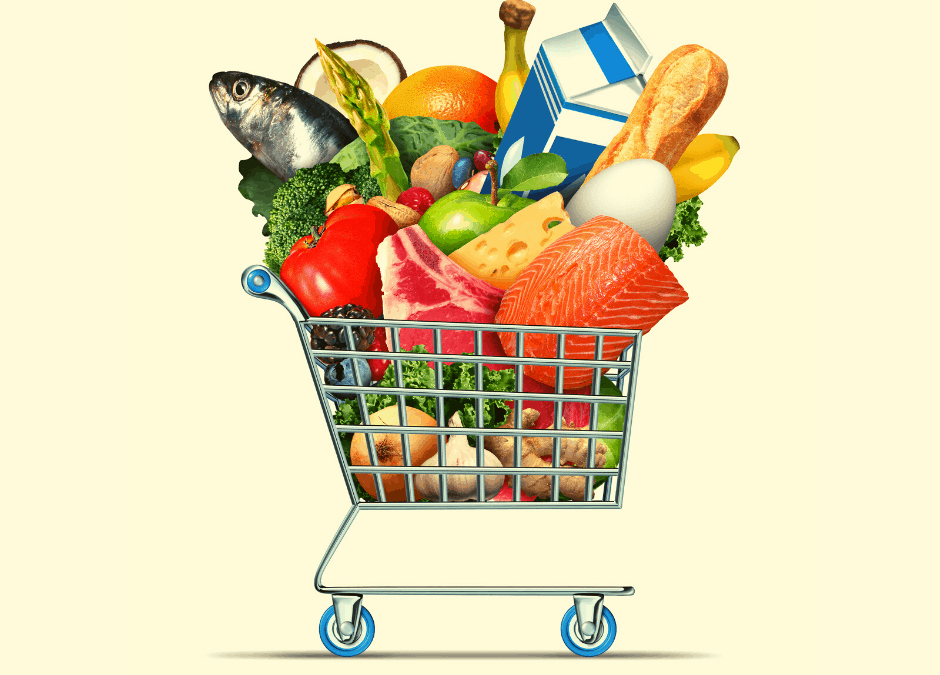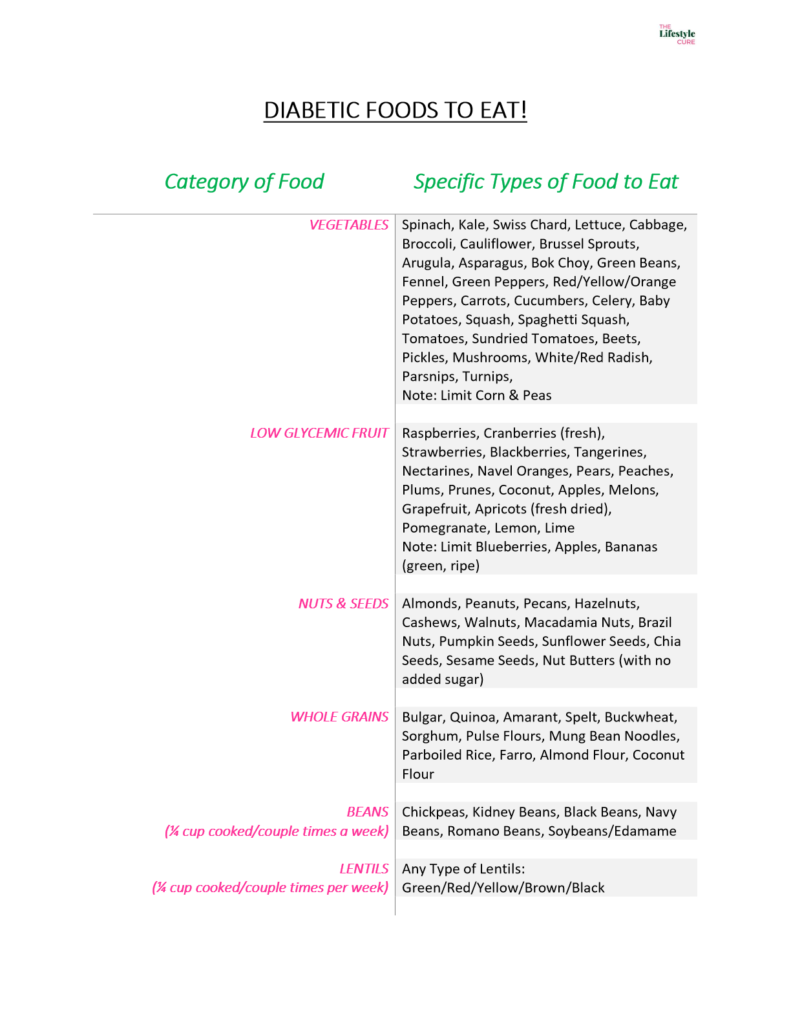
When it comes to diabetes, a healthy diet can not only lower your blood sugar but can also reverse your diagnosis all together. A diabetic food list can help those suffering from type 2 diabetes or prediabetes know exactly what foods to eat and what to avoid. Whether that’s at home, a restaurant or while grocery shopping this food list can be taken anywhere. But why is it so important? Let’s find out.
Diabetes Mellitus is a chronic, metabolic disease characterized by elevated levels of blood glucose (sugar). If not controlled, diabetes can lead to serious complications of the heart, blood vessels, nerves, eyes and kidneys.
Normally the pancreas releases insulin which helps glucose get into the cells to be used for energy. However, this function is impaired in those who have diabetes.
Types of Diabetes
Type 1 diabetes, also called insulin-dependent diabetes is caused by an autoimmune reaction. The immune system in this case attacks itself, specifically the pancreas, causing damage and destroying the cells that produce insulin.
Type 2 diabetes is more common and accounts for 90% of all diabetes cases. Here, the pancreas does not produce enough insulin or doesn’t use insulin well. This results in more glucose in the blood and less reaching the cells which can be harmful to many organs.
Although scary, type 2 diabetes can be reversed with lifestyle changes.
Gestational diabetes occurs when there is high blood sugar during pregnancy which can potentially affect the mother and the baby.
What is Prediabetes?
Prediabetes is a silent health condition which many Americans are unknowingly living with. Here, the blood sugar is higher than normal but not high enough to be considered type 2 diabetes.
Again, like type 2 diabetes, prediabetes can also be prevented and reversed with lifestyle changes such as a pre diabetic diet.
What is glycemic index?
The glycemic index (GI) is a scale that ranks carbohydrates-containing foods or drinks from 0 to 100 depending upon how much they raise blood glucose levels after it’s consumed. Low GI foods (≤ 55 GI units) are considered better for diabetics due to there slow and steady increase in blood glucose levels. High GI foods (≥ 70 GI units) increase blood glucose at a higher and faster rate and should be avoided as much as possible for those with prediabetes and type 2 diabetes.
Diabetes do’s and don’t’s
Diabetes do’s will always be whole foods. What does that mean? It means you should be eating foods like:
Vegetables – are filled with fiber, protein and nutrients which helps to nourish the body, maintain blood sugar and keep you full. Non-starchy vegetables in particular are great for diabetics because they are low in carbohydrates keeping blood glucose under control.
Fruits – even though fruits contain carbohydrates diabetics can still have them, they just need to be counted as a part of your meal plan. It’s best to choose fruits that are fresh, frozen or canned without added sugars.
Unsalted Nuts and seeds – should be included in a diabetic diet because they contain magnesium and high levels of beneficial fats. These healthy fats help to both improve glycemic control and help diabetics reduce the risk of heart disease.
Whole grains – are foods with good sources of fiber which can help slow the absorption of glucose in the blood.
Beans – are packed with protein and fiber which have been shown to lower blood glucose levels in diabetics.
Lentils – are complex carbs meaning they are high in fiber and digest slowly. They help not only control blood glucose levels but also appetite.
Fermented foods- are rich in fiber which can stabilize blood glucose and help in weight loss. One study in particular showed these foods to reduce fasting blood glucose, postprandial blood glucose, glucose intolerance and insulin resistance.
Eggs – have a low GI score, great for your waistline and are high in protein which is why it can be included in a diabetic diet. However, it’s important to eat in moderation as it can affect cholesterol which is something to be mindful of since diabetes is a risk factor for cardiovascular disease.
Avocados- have many diabetes benefits including low in carbohydrates, high in fiber, may help with weight loss and improve insulin sensitivity.
Organic, grass fed animal-protein – are loaded with complete protein, rich in vitamins and minerals, and contain healthy omega-3 fatty acids all things good for a diabetic diet.
Herbs and Spices – are great to add to your dishes for flavor, satiety and a whole host of benefits. Particularly for diabetics, they bioactive compounds found in many culinary herbs and spices showed reduced blood glucose and fat.
Diabetes dont’s are foods that should be limited and they are:
Processed/refined carbs – these foods are stripped of almost all fiber, vitamins and minerals and can be considered empty calories. These are high GI foods that cause rapid spikes in blood sugar levels.
Processed meats – can increase cholesterol and weight which can be harmful for diabetics.
High GI fruits – can increase blood glucose quickly making it difficult to control.
Canned foods with added sodium or sugar.
Pre-Packaged, frozen and fast foods – often contain hidden sugars, salt and preservatives which you should be wary of.
Unhealthy fats – are trans fats that are bad for the waistline and heart especially for diabetics.
Low-fat products – tend to replace fat with sugar.
Salty – can raise blood pressure in diabetics putting them more at risk for heart disease
Sweetened beverages – can create imbalances in a person’s insulin levels.
Alcohol – should be had in moderation.
What Foods Can Diabetics Eat Freely- Diabetic Food List
Diet is the cornerstone when it comes to managing blood sugars, which is why it’s important to know what foods diabetics can eat freely and which ones they cannot. By having a diabetic friendly food list on hand, you will not only understand what constitutes a diabetic diet but it will also help you stay on track.
The best way to use this this list is while grocery shopping or you can pin it to the fridge as a reminder when you go to eat. Additionally, this list of foods can also be used for those who are prediabetic.
Now that we know the basics here is:
Diabetic Food List What To Eat

You need to lose weight, and exercise (more), because these two lowers your insulin resistance, that underlies type 2 diabetes.
The DIRECT Study see Durability of a primary care-led weight-management intervention for remission of type 2 diabetes: 2-year results of the DiRECT open-label, cluster-randomised trial lead by Profesor Michael Lean where participants followed a 825–875 Cal diet for 6 months, showed that 74% of those who lost more than 10 kg, and kept it off for 2 years, were still in remission (that is having no clinical diabetes anymore) of their diabetes after 2 years. As you can see in the graph no effect if one didn’t lose enough weight:
From other trials we know that exercising (which can be taking a brisk walk) for at least 150 minutes a week will do.
Although blood glucose levels of 300mg per deciliters are quite high,it won’t kill you, if you’re willing to do that very low calori diet, it will come down within two-three weeks. That’s if you don’t cheat, the hardest part of following such a strict diet, see the number of failures, the numbers under the left columns in the graph.
In an earlier pilot study Professor Roy Taylor Reversal of type 2 diabetes: normalisation of beta cell function in association with decreased pancreas and liver triacylglycerolshowed that on a very low caloric 600 Cal diet blood glucose AFTER STOPPING ALL ANTIDIABETIC MEDS ( including insulin) normalized within one week after starting that very low caloric diet.
So, if you really want to lower your blood glucose levels, go on a very low caloric diet, and before losing much weight your blood glucose levels will go down, even normalize, after one week.
To fill my stomach I have 2 lbs of green leavy veggies daily, that takes care of my dietary fiber and micronutrient needs too.
All the best!

ليست هناك تعليقات:
إرسال تعليق